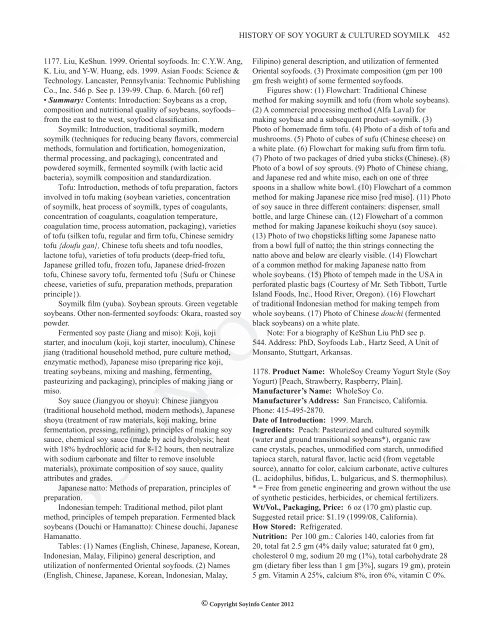history of soy yogurt, soy acidophilus milk and other ... - SoyInfo Center
history of soy yogurt, soy acidophilus milk and other ... - SoyInfo Center
history of soy yogurt, soy acidophilus milk and other ... - SoyInfo Center
Create successful ePaper yourself
Turn your PDF publications into a flip-book with our unique Google optimized e-Paper software.
1177. Liu, KeShun. 1999. Oriental <strong>soy</strong>foods. In: C.Y.W. Ang,<br />
K. Liu, <strong>and</strong> Y-W. Huang, eds. 1999. Asian Foods: Science &<br />
Technology. Lancaster, Pennsylvania: Technomic Publishing<br />
Co., Inc. 546 p. See p. 139-99. Chap. 6. March. [60 ref]<br />
• Summary: Contents: Introduction: Soybeans as a crop,<br />
composition <strong>and</strong> nutritional quality <strong>of</strong> <strong>soy</strong>beans, <strong>soy</strong>foods–<br />
from the east to the west, <strong>soy</strong>food classifi cation.<br />
Soy<strong>milk</strong>: Introduction, traditional <strong>soy</strong><strong>milk</strong>, modern<br />
<strong>soy</strong><strong>milk</strong> (techniques for reducing beany fl avors, commercial<br />
methods, formulation <strong>and</strong> fortifi cation, homogenization,<br />
thermal processing, <strong>and</strong> packaging), concentrated <strong>and</strong><br />
powdered <strong>soy</strong><strong>milk</strong>, fermented <strong>soy</strong><strong>milk</strong> (with lactic acid<br />
bacteria), <strong>soy</strong><strong>milk</strong> composition <strong>and</strong> st<strong>and</strong>ardization.<br />
T<strong>of</strong>u: Introduction, methods <strong>of</strong> t<strong>of</strong>u preparation, factors<br />
involved in t<strong>of</strong>u making (<strong>soy</strong>bean varieties, concentration<br />
<strong>of</strong> <strong>soy</strong><strong>milk</strong>, heat process <strong>of</strong> <strong>soy</strong><strong>milk</strong>, types <strong>of</strong> coagulants,<br />
concentration <strong>of</strong> coagulants, coagulation temperature,<br />
coagulation time, process automation, packaging), varieties<br />
<strong>of</strong> t<strong>of</strong>u (silken t<strong>of</strong>u, regular <strong>and</strong> fi rm t<strong>of</strong>u, Chinese semidry<br />
t<strong>of</strong>u {doufu gan}, Chinese t<strong>of</strong>u sheets <strong>and</strong> t<strong>of</strong>u noodles,<br />
lactone t<strong>of</strong>u), varieties <strong>of</strong> t<strong>of</strong>u products (deep-fried t<strong>of</strong>u,<br />
Japanese grilled t<strong>of</strong>u, frozen t<strong>of</strong>u, Japanese dried-frozen<br />
t<strong>of</strong>u, Chinese savory t<strong>of</strong>u, fermented t<strong>of</strong>u {Sufu or Chinese<br />
cheese, varieties <strong>of</strong> sufu, preparation methods, preparation<br />
principle}).<br />
Soy<strong>milk</strong> fi lm (yuba). Soybean sprouts. Green vegetable<br />
<strong>soy</strong>beans. Other non-fermented <strong>soy</strong>foods: Okara, roasted <strong>soy</strong><br />
powder.<br />
Fermented <strong>soy</strong> paste (Jiang <strong>and</strong> miso): Koji, koji<br />
starter, <strong>and</strong> inoculum (koji, koji starter, inoculum), Chinese<br />
jiang (traditional household method, pure culture method,<br />
enzymatic method), Japanese miso (preparing rice koji,<br />
treating <strong>soy</strong>beans, mixing <strong>and</strong> mashing, fermenting,<br />
pasteurizing <strong>and</strong> packaging), principles <strong>of</strong> making jiang or<br />
miso.<br />
Soy sauce (Jiangyou or shoyu): Chinese jiangyou<br />
(traditional household method, modern methods), Japanese<br />
shoyu (treatment <strong>of</strong> raw materials, koji making, brine<br />
fermentation, pressing, refi ning), principles <strong>of</strong> making <strong>soy</strong><br />
sauce, chemical <strong>soy</strong> sauce (made by acid hydrolysis; heat<br />
with 18% hydrochloric acid for 8-12 hours, then neutralize<br />
with sodium carbonate <strong>and</strong> fi lter to remove insoluble<br />
materials), proximate composition <strong>of</strong> <strong>soy</strong> sauce, quality<br />
attributes <strong>and</strong> grades.<br />
Japanese natto: Methods <strong>of</strong> preparation, principles <strong>of</strong><br />
preparation.<br />
Indonesian tempeh: Traditional method, pilot plant<br />
method, principles <strong>of</strong> tempeh preparation. Fermented black<br />
<strong>soy</strong>beans (Douchi or Hamanatto): Chinese douchi, Japanese<br />
Hamanatto.<br />
Tables: (1) Names (English, Chinese, Japanese, Korean,<br />
Indonesian, Malay, Filipino) general description, <strong>and</strong><br />
utilization <strong>of</strong> nonfermented Oriental <strong>soy</strong>foods. (2) Names<br />
(English, Chinese, Japanese, Korean, Indonesian, Malay,<br />
HISTORY OF SOY YOGURT & CULTURED SOYMILK 452<br />
© Copyright Soyinfo <strong>Center</strong> 2012<br />
Filipino) general description, <strong>and</strong> utilization <strong>of</strong> fermented<br />
Oriental <strong>soy</strong>foods. (3) Proximate composition (gm per 100<br />
gm fresh weight) <strong>of</strong> some fermented <strong>soy</strong>foods.<br />
Figures show: (1) Flowchart: Traditional Chinese<br />
method for making <strong>soy</strong><strong>milk</strong> <strong>and</strong> t<strong>of</strong>u (from whole <strong>soy</strong>beans).<br />
(2) A commercial processing method (Alfa Laval) for<br />
making <strong>soy</strong>base <strong>and</strong> a subsequent product–<strong>soy</strong><strong>milk</strong>. (3)<br />
Photo <strong>of</strong> homemade fi rm t<strong>of</strong>u. (4) Photo <strong>of</strong> a dish <strong>of</strong> t<strong>of</strong>u <strong>and</strong><br />
mushrooms. (5) Photo <strong>of</strong> cubes <strong>of</strong> sufu (Chinese cheese) on<br />
a white plate. (6) Flowchart for making sufu from fi rm t<strong>of</strong>u.<br />
(7) Photo <strong>of</strong> two packages <strong>of</strong> dried yuba sticks (Chinese). (8)<br />
Photo <strong>of</strong> a bowl <strong>of</strong> <strong>soy</strong> sprouts. (9) Photo <strong>of</strong> Chinese chiang,<br />
<strong>and</strong> Japanese red <strong>and</strong> white miso, each on one <strong>of</strong> three<br />
spoons in a shallow white bowl. (10) Flowchart <strong>of</strong> a common<br />
method for making Japanese rice miso [red miso]. (11) Photo<br />
<strong>of</strong> <strong>soy</strong> sauce in three different containers: dispenser, small<br />
bottle, <strong>and</strong> large Chinese can. (12) Flowchart <strong>of</strong> a common<br />
method for making Japanese koikuchi shoyu (<strong>soy</strong> sauce).<br />
(13) Photo <strong>of</strong> two chopsticks lifting some Japanese natto<br />
from a bowl full <strong>of</strong> natto; the thin strings connecting the<br />
natto above <strong>and</strong> below are clearly visible. (14) Flowchart<br />
<strong>of</strong> a common method for making Japanese natto from<br />
whole <strong>soy</strong>beans. (15) Photo <strong>of</strong> tempeh made in the USA in<br />
perforated plastic bags (Courtesy <strong>of</strong> Mr. Seth Tibbott, Turtle<br />
Isl<strong>and</strong> Foods, Inc., Hood River, Oregon). (16) Flowchart<br />
<strong>of</strong> traditional Indonesian method for making tempeh from<br />
whole <strong>soy</strong>beans. (17) Photo <strong>of</strong> Chinese douchi (fermented<br />
black <strong>soy</strong>beans) on a white plate.<br />
Note: For a biography <strong>of</strong> KeShun Liu PhD see p.<br />
544. Address: PhD, Soyfoods Lab., Hartz Seed, A Unit <strong>of</strong><br />
Monsanto, Stuttgart, Arkansas.<br />
1178. Product Name: WholeSoy Creamy Yogurt Style (Soy<br />
Yogurt) [Peach, Strawberry, Raspberry, Plain].<br />
Manufacturer’s Name: WholeSoy Co.<br />
Manufacturer’s Address: San Francisco, California.<br />
Phone: 415-495-2870.<br />
Date <strong>of</strong> Introduction: 1999. March.<br />
Ingredients: Peach: Pasteurized <strong>and</strong> cultured <strong>soy</strong><strong>milk</strong><br />
(water <strong>and</strong> ground transitional <strong>soy</strong>beans*), organic raw<br />
cane crystals, peaches, unmodifi ed corn starch, unmodifi ed<br />
tapioca starch, natural fl avor, lactic acid (from vegetable<br />
source), annatto for color, calcium carbonate, active cultures<br />
(L. <strong>acidophilus</strong>, bifi dus, L. bulgaricus, <strong>and</strong> S. thermophilus).<br />
* = Free from genetic engineering <strong>and</strong> grown without the use<br />
<strong>of</strong> synthetic pesticides, herbicides, or chemical fertilizers.<br />
Wt/Vol., Packaging, Price: 6 oz (170 gm) plastic cup.<br />
Suggested retail price: $1.19 (1999/08, California).<br />
How Stored: Refrigerated.<br />
Nutrition: Per 100 gm.: Calories 140, calories from fat<br />
20, total fat 2.5 gm (4% daily value; saturated fat 0 gm),<br />
cholesterol 0 mg, sodium 20 mg (1%), total carbohydrate 28<br />
gm (dietary fi ber less than 1 gm [3%], sugars 19 gm), protein<br />
5 gm. Vitamin A 25%, calcium 8%, iron 6%, vitamin C 0%.












